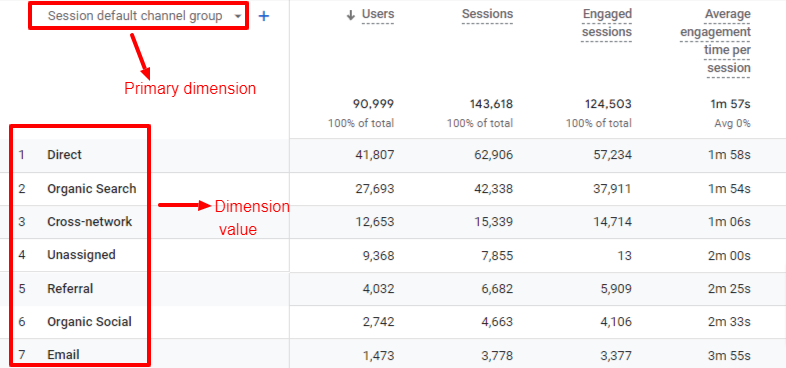Unlock Deeper Insights With Secondary Measurement in Google Analytics
With the huge expanse of information available in Google Analytics, the application of secondary dimensions can considerably improve your analytical abilities. By purposefully integrating second measurements right into your evaluation, you can uncover important understandings that may or else remain undiscovered - Secondary Dimension in Google Analytics.
Understanding Primary Vs. Second Dimensions
On the other hand, second measurements allow you to more study your main measurement data. By adding an additional dimension, you can layer on extra information to your key measurement, allowing a much more granular evaluation. If your key measurement is the source/medium through which users got here on your site, including an additional dimension like geographical place can disclose where those individuals are situated geographically.
Using Second Dimensions Effectively
Effectively making use of secondary dimensions in Google Analytics improves the depth and granularity of data evaluation, supplying useful understandings into customer habits and patterns. By including additional dimensions along with main dimensions, marketing experts and analysts can delve much deeper right into the specifics of individual communications on their sites. Second measurements permit users to sector and filter key measurement information additionally, providing a more thorough sight of individual interactions, actions, and demographics. This can be especially useful when attempting to understand the impact of certain variables on individual interaction, such as the browsers or devices they are utilizing, the sources of their web traffic, or their geographic locations.
Additionally, secondary dimensions enable customers to compare and contrast different information factors within a single record, assisting in a much more extensive analysis of user behavior patterns. By leveraging secondary dimensions efficiently, organizations can reveal hidden understandings, optimize their advertising strategies, and enhance the overall user experience on their web sites.
Discovering Typical Second Dimension Mixes
To better assess user habits and patterns in Google Analytics, it is useful to discover usual combinations of additional measurements. By combining various second dimensions, analysts and online marketers can acquire deeper insights into how numerous elements impact and engage website performance. Some common secondary dimension combinations that supply valuable understandings consist of examining web traffic resources with user places to comprehend where website visitors are coming from geographically and how they discovered the website. Similarly, combining landing pages with gadgets can expose which web pages do best on various tools, aiding in enhancing the site for far better user experience. Analyzing user actions metrics with second measurements such as demographics or rate of interests can aid in targeting details target market segments a lot more successfully. By checking out these usual additional measurement mixes, companies can uncover surprise patterns, identify opportunities for enhancement, and make data-driven decisions to boost their on-line existence.
Using Additional Measurement in Custom-made Reports
Utilizing second dimensions in custom-made records enables a much more extensive evaluation of data in Google Analytics, boosting the deepness of understandings acquired. When creating customized records in Google Analytics, including additional dimensions can offer an extra comprehensive view of just how numerous dimensions interact with each other. This feature enables customers to delve deeper into their information and uncover important relationships that may not be immediately apparent.
By browse around here using additional measurements in customized reports, individuals can gain a better understanding of their site or app website traffic. For instance, incorporating the main measurement of "source/medium" with the second dimension of "touchdown page" can disclose which landing web pages are doing finest for traffic coming from details resources. This insight can aid marketers optimize their campaigns and enhance overall conversion prices.

Enhancing Data Visualization With Secondary Dimension
When exploring data in Google Analytics custom-made reports, including additional measurements not just offers an extra detailed evaluation but also improves the graph of insights via data visualization. By including a secondary measurement to your reports, you can improve the method information exists, making it less complicated to Visit Website recognize patterns, patterns, and connections within your web site's efficiency metrics.
Second dimensions can assist you sector your information even more, permitting a deeper understanding of user behavior and interactions on your website. This boosted degree of granularity can be particularly valuable when trying to isolate details variables that might influence your web site's performance - Secondary Dimension in Google Analytics.

Verdict
To conclude, leveraging second measurements in Google Analytics permits an extra comprehensive evaluation of data, leading to deeper understandings and even more educated decision-making. Secondary Dimension in Google Analytics. By adding additional layers of details to key information sets, marketing experts and experts can reveal surprise patterns, patterns, and connections that give a granular view of user habits and interactions. This improved degree of understanding allows optimization of projects and tailored techniques for particular audience segments, inevitably improving efficiency and conversion prices
On the here are the findings various other hand, secondary dimensions allow you to further study your key measurement information. By adding a second measurement, you can layer on additional information to your main measurement, making it possible for a much more granular analysis. If your key measurement is the source/medium with which customers showed up on your site, adding an additional measurement like geographical area can disclose where those individuals are located geographically. By integrating secondary dimensions alongside key dimensions, experts and marketers can dive much deeper right into the specifics of individual interactions on their websites. Secondary dimensions allow customers to segment and filter key measurement data even more, offering a much more comprehensive view of user interactions, demographics, and behaviors.
Comments on “Secondary Dimension in Google Analytics: Finest Practices and Tips”